The Serapeum of Saqqara is a grand underground burial site built between 1400 BC and 30 BC for the sacred Apis bulls, worshiped as divine manifestations of the god Ptah. These revered animals were entombed with elaborate rituals in massive granite sarcophagi, some weighing up to 62 tons. Originating under Amenhotep III and later expanded by Prince Khaemweset and during the Ptolemaic era, the complex blends Egyptian and Hellenistic styles, with sphinx-lined avenues, vaulted chambers, and richly decorated corridors. Discovered in 1850 by Auguste Mariette, it remains an archaeological marvel, though mysteries about construction, bull selection, and hidden chambers persist. Ongoing restoration since 2020 continues to uncover its secrets.
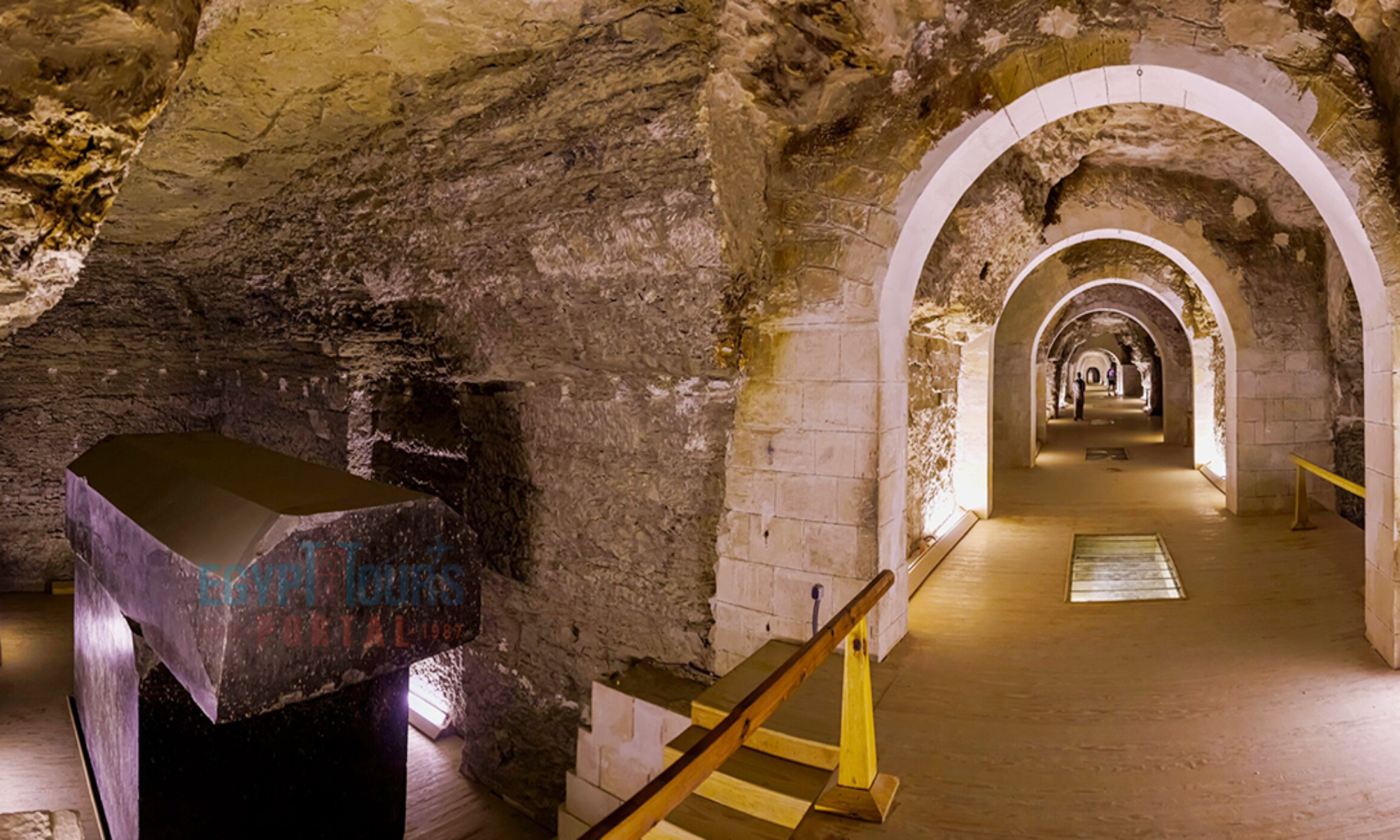
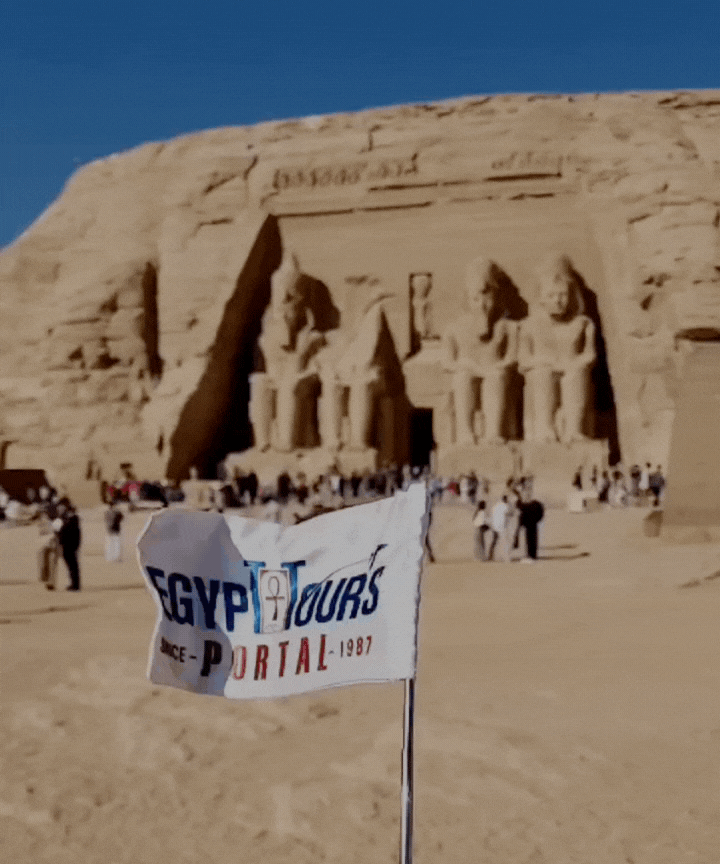
Serapeum of Saqqara, or the burial vaults of the mother cows of the Apis, is a mythical and celestial creation of magic that bridged a gap between the heavenly and ethereal realms of Egypt by honoring the animals of the ancient Egyptian gods. The Serapeum at Saqqara was the tomb of the sacred Apis bulls, which were the incarnations of the creator god of craftsmanship and art, Ptah, who then after death, becomes immortal in the form of Osiris-Apis.
It is found around 30 kilometers south of modern-day Cairo and is known as the most enigmatic and historically significant sites in Egyptian archaeology, known for its extraordinary architectural feats and the mysterious manner in which it was constructed. The Serapeum is one of two magnificent ancient Egyptian temples dedicated to the worship of the Greco-Egyptian god Serapis (Sarapis). The Serapeum has gained the interest of many people across history and the ancient civilizations of the world, even to our current time.
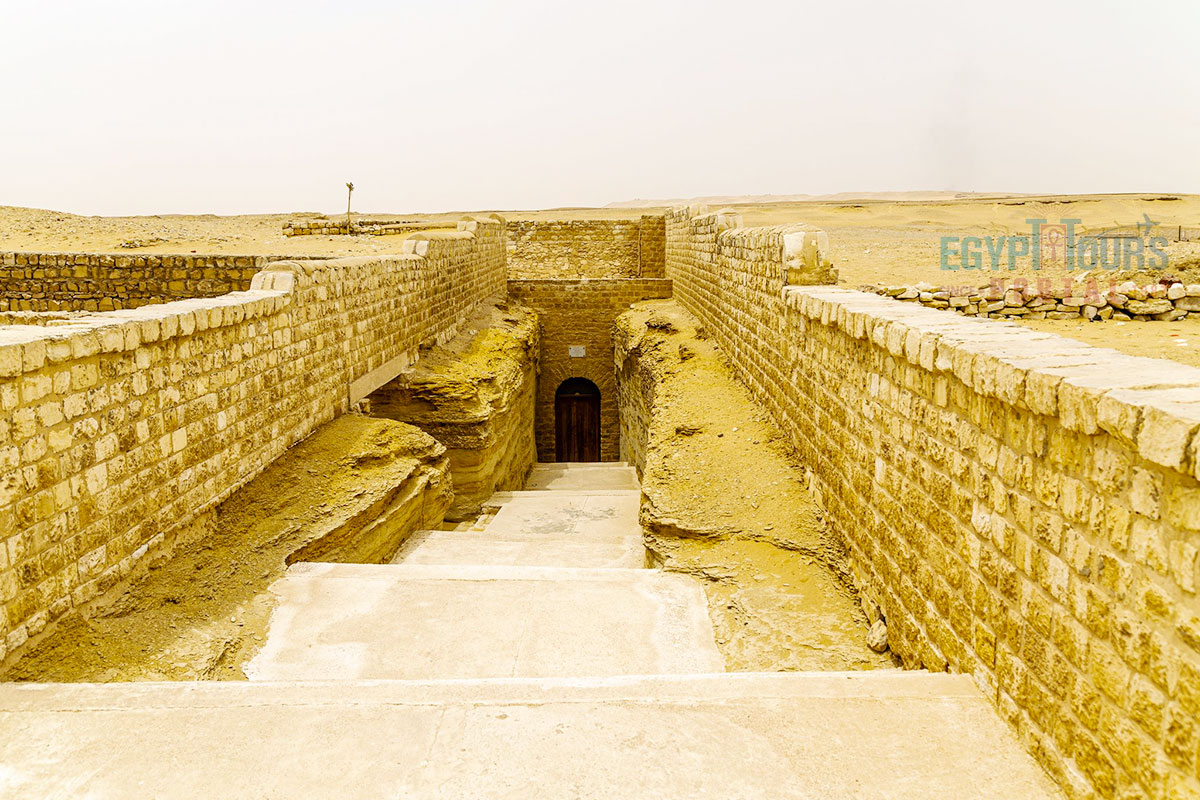
The Serapeum of Saqqara was created around 1400 BC to 30 BC from the New Kingdom (1550 – 1070 BC) to the Ptolemaic era (305 – 30 BC), but the usage of the Apis cult can be historically traced to the time of Pharaoh Menes around 3000 BC. It was dedicated to Apis, the sacred bull deity who was believed to be an incarnation of the god Ptah. Apis was revered as a symbol of strength, fertility, and the renewal of life. The bulls were considered to be living manifestations of the god, and their burials were treated with utmost reverence.
One of the oldest tombs found in the Serapeum dates to the reign of Amenhotep III of the 18th dynasty during the 14th century BC. From the time of the last original pharaoh of Egypt Amasis II of the 26th dynasty, till the end of the Ptolemaic dynasty, all the sarcophagi for the Apis bulls were carved of hard stone, including the lid, which weighed around 62 tonnes (68 short tons). Under the reign of Nectanebo I, (379–361 BC), the founder of the Thirtieth Dynasty, a long avenue of 370-380 sphinxes was made.
During the start of the Roman period around 30 BC, the entire area was abandoned and covered by sand, but the ritual of burning Apis continued in other places in the region of Saqqara-Abusir region until the 3rd century AD, and anyone who revealed the place of Apis was penalized. Looting the serapeum was an going process when the hieroglyphs could still be read and understood, but they were desecrated and plundered, as only two tombs are intact. The bull mummies were torn to pieces, and the sarcophagi’s stone was piled on as a sign of content.

The Serapeum is a remarkable piece of ancient Egyptian architecture that stands as a magical testament to the skill and artistry of the Egyptian builders, which is a reminder of the importance of the Apis bulls in ancient Egyptian religion. The architecture of the Serapeum is a magnificent blend of ancient Egyptian and Greek styles. The main entrance to the complex is a monumental gateway that is decorated with marvelous hieroglyphs and reliefs depicting the Apis bulls of Ptah. The gateway leads to a long, straight corridor that is lined with smaller chambers.
These chambers once housed mummified bulls, which were placed in huge granite sarcophagi that were extremely heavy. It held around 60 apis tombs, thus forming a great cult. Some underground galleries were created, thus connecting subsequent burial chambers created by digging underground, which connects to subsequent burial chambers. While on the ground above, the enclosure's main temple was supplemented by some workshops, shrines, housing, and administrative quarters. Prince Khaemweset, son of Ramesses the Great (1279–1213 BC) in the Nineteenth Dynasty, excavated a great tunnel with side chambers known as “Lesser Vaults” to be a burial ground of Apis Bulls.
The greater vaults of the Serapeum were started under Psamtik I (664–610 BC) of the 26th dynasty, which extended during the Ptolemaic dynasty. The most impressive part of the Serapeum is the Great Gallery, which is a long, vaulted chamber that is 300 meters (984 feet) long and 14 meters (46 feet) wide. The gallery is lined with 24 openings, each of which leads to a chamber that contains a granite sarcophagus. The sarcophagi are all different sizes, and some of them weigh up to 300 tons.
Some of the most notable architectural features of the Serapeum include: The gateway is made of limestone and is decorated with hieroglyphs and reliefs depicting the Apis bulls. The corridor is lined with smaller chambers that once housed the mummified bulls. The Great Gallery is a long, vaulted chamber that is lined with 24 openings, each of which leads to a chamber that contains a granite sarcophagus. The complex is decorated with hieroglyphs and reliefs depicting the Apis bulls, as well as other gods. The long avenue of 370-380 sphinxes that was made by Nectanebo I (379–361 BC) is one of the most magical pieces of artistic design.
Many stelae belong to many kings who wished to immortalize their dedication to the gods, like the legendary Stela of Amasis I, which shows Amasis II godly achievements, what Horus had done for his father Osiris, his love for his Apis, and more incredible facts. There is also the Stela of Darius I dedicated to his Apia, who passed away in the fourth year of his reign. There are also some stelas such as Stela of Ptolemy III, Stela of Ptolemy V, stela of Psamtik I, stela of Darius I, and Stela of Ptolemy V.
Explore the great powers of the ancient gods and goddesses of Egypt.
Read More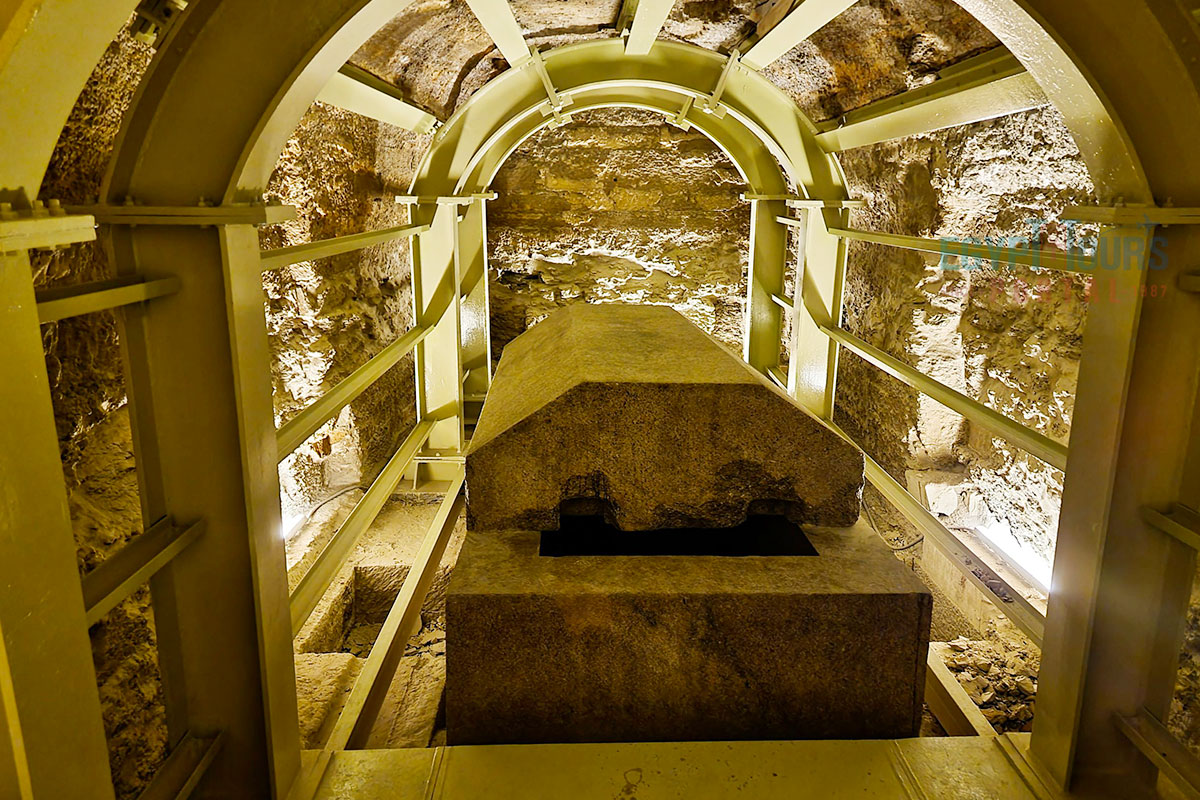
The Rituals of the Apis had a great significance as every Apis had four stops in their lives that marked their career, which are the birth, the installation, the death, and the burial. The famous Greek historian Diodorus Siculus (90–30 BC) stated that the Apis were honored and glorified like the gods and were consecrated to Osiris, plus were highly connected to the Sed Festival. When the old Apis died, the priest believed that the soul of Osiris had attached itself to the body of the young bull.
The apis bull had to be black with three spts across its body and its forehead which need to resemble the likeness of an eagle on its back, a knot under its tongue, and double tail-hairs which held several meanings that symbolizes the stars, the shape of the crescent moon and the overall universe, plus the time of which the nile river would rise. When the Apis was born, mourning for the previous Apis would stop, and everyone was allowed to look at it.
The mother cows were said to be impregnated by the light of heaven or the moonlight, and they lived and were buried with the Apis at Memphis in their catacomb, which is one km north-east of the Serapeum. According to the Apis papyrus, when the Apis would die, some of its parts were consumed while the other remains were put in bituminous or resin and placed in canopic jars and nested coffins, then buried in their sarcophagus. The burial ceremonies last for about 70 days. The Apis bull was embalmed for 68 days, and on the last two days, a series of funerary processions were held. The bulls were buried on the last day with 2.6 tonnes of silver.
Explore the relationship between the ancient Egyptian Religion and the way of life of the ancient Egyptians mummified the dead.
Read More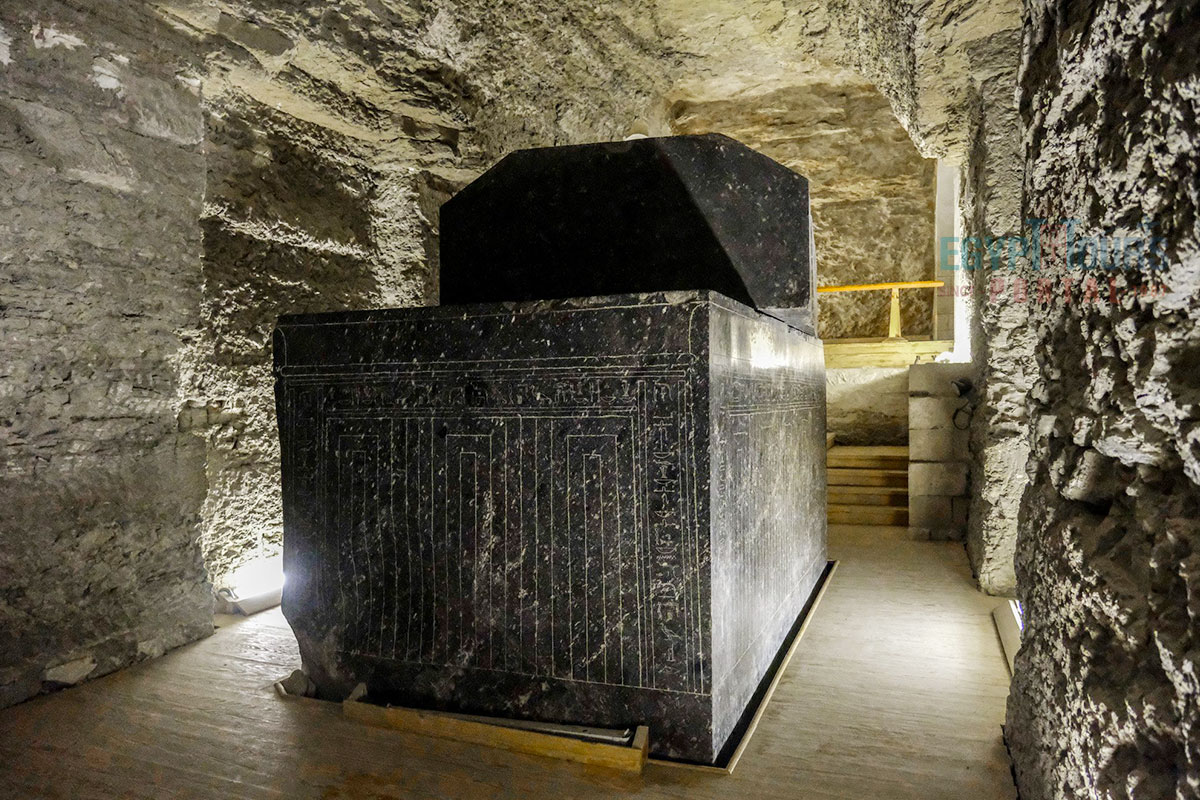
In the fascinating Greater Vaults, a collection of 24 sarcophagi has been preserved through the ages. The oldest among them dates back to the time of Amasis II, who was a prominent native ruler around 550 BC. Remarkably, the final sarcophagus was created some 500 years later, during the reign of the illustrious Roman emperor Augustus. These sarcophagi are truly masterpieces of art when talking about their dimensions and weight. Most of them surpass 2 meters (6.6 feet) in width and height, and they are nearly twice as long. These colossal coffins weigh approximately 40 tonnes (88,000 pounds), with their lids being about half as heavy.
A captivating discovery within the Serapeum are the winches, rollers, and rails provide valuable insights into the ancient engineering used to transport these massive stones through the narrow tunnels. During the 18th and 19th dynasties of Egypt, specifically spanning approximately 160 years (1390 - 1250 BC), Isolated Tombs were constructed. These ancient Egyptian tombs were built between the reigns of Amenhotep III and Ramesses II. Following this period, underground galleries were excavated to establish connections between the subsequent Apis burial chambers.
Interestingly, during the placement process, the sarcophagi were skillfully lowered into their final positions by removing the sand that had been previously filled in the burial chambers. This meticulous procedure highlights the reverence and care with which the ancient civilizations approached their burial rituals. A noteworthy point of distinction lies in the material composition of these grand coffers. All the surviving sarcophagi are hewn from "costly stone," such as granite, basalt, diorite, and other valuable materials. However, it is believed that the older sarcophagi, now unfortunately lost to time, may have been crafted from limestone.
In the Greater Vaults, there are 24 sarcophagi still present. Among them, three bear notable dedications by historical figures: Amasis II, Cambyses II, and Khabash. Another sarcophagus, which contains empty cartouches, remains undated, but it is likely to have originated during the reign of either Ptolemy XII or Cleopatra. Intriguingly, four of these monumental sarcophagi bear inscriptions, believed to be dedications or perhaps spells from the pyramid or coffin texts. Among these four, two also feature additional artistic decorations, providing us with a glimpse into the symbolic significance of these burial artifacts.
One great example of these marvelous sarcophaguses is a particular sarcophagus that has been found to possess astonishing massiveness. Calculations reveal that it weighs up to an astounding 62 tonnes (137,000 pounds) in total. The body itself contributes to 37.6 tonnes (83,000 pounds), while the lid accounts for 24.4 tonnes (54,000 pounds). The external dimensions of this monumental stone measure 2.32 meters (7.6 feet) in height and width, with a length of 3.85 meters (12.6 feet). Inside, the rectangular hollow stands at 1.73 meters (5.7 feet) in height, 1.46 meters (4.8 feet) in width, and 3.17 meters (10.4 feet) in length. The lid, crowning this impressive piece, reaches a height of 98 centimeters (3.22 feet).

Auguste Mariette, who originally in Egypt to collect Coptic-language manuscripts, stumbled upon the remarkable temple while exploring the Saqqara necropolis. His discovery began in 1850 when he uncovered the head of a sphinx partially buried in shifting desert sands. Intrigued, he continued the excavation, ultimately reaching the catacombs a year later. Regrettably, much of Mariette's invaluable documentation remained unpublished, and a devastating flood in 1878 resulted in the loss of many of his notes stored at the Museum of Egyptian Antiquities in Boulaq. Moreover, Eugène Grébaut borrowed Mariette's original excavation diary but never returned it.
After Mariette's passing, Gaston Maspero published one volume of Le Sérapeum de Memphis in 1882, drawing from the surviving manuscripts. Following the collapse of the Lesser Vaults' ceiling, Auguste Mariette chose not to explore a significant section of the area, leaving it uncharted, covering several tens of meters. In the mid-1980s, a valiant attempt was made to resume excavation in the same region.
However, the perilous condition of the site and the looming risk of further collapse compelled him to abandon his efforts. A fresh undertaking commenced in 2020, with the primary objective of removing the accumulated sand on top of the Lesser Vaults and stabilizing the underlying bedrock. This crucial process aimed to mitigate potential collapse hazards and establish a secure environment for future excavation work to proceed successfully.

The Serapeum of Saqqara holds several mysteries that continue to intrigue archaeologists and historians for a long period since its excavation. The general purpose of the Serapeum as a burial complex for the Apis bulls, and some specific details of the religious rituals and ceremonies associated with the burials, remain unknown. One of the most significant mysteries surrounding the Serapeum is the method used by the ancient Egyptians to transport the massive granite sarcophagi from the quarries to the burial site, which each weighed several tons, and were crafted from challenging material to work with, “solid granite”.
Some explanations suggest the use of ramps, levers, and manpower, but no concrete evidence has been found to definitively explain this feat. Another mystery pertains to the criteria the ancient Egyptians used to select the Apis bulls to be buried in the Serapeum. While it is believed that certain markings or characteristics were considered when choosing the bulls, the precise selection process is not fully understood. Understanding the reasons behind the choice of specific bulls could provide valuable insights into the religious beliefs and practices of ancient Egypt.
The purpose of the elaborate underground galleries of the Serapeum is not entirely clear. It also holds additional chambers or hidden passages yet to be discovered. These hidden areas could potentially shed light on other aspects of ancient Egyptian culture and religious practices, and the main significance and importance of the incredible Serapeum of Saqqara. Further research and excavation are in the ways that will unveil additional details about the religious significance and practices conducted within the Serapeum.
The Serapeum of Saqqara stands as a testament to the ingenuity, religious devotion, and advanced engineering, artistic, and architectural skills of ancient Egyptian civilization. Its underground galleries, massive granite sarcophagi, and intricate rituals associated with the cult of Apis offer valuable insights into the beliefs and practices of ancient Egypt.
Despite the mysteries that still surround this awe-inspiring site, the Serapeum continues to be a source of fascination and wonder for archaeologists, historians, and visitors alike, providing a glimpse into the ancient world's reverence for its sacred animals and the mysteries of life and death. Our travelers from all over the world will enjoy the most fascinating Egypt vacation and the most satisfactory Nile river cruise while exploring all the magical ancient cities of this golden civilization.
Private 4 Days Cairo Tour Packages 4 days Cairo Egypt tour package will offer a bles...
Tour Location: Cairo – Giza...
Stunning 5 Days Cairo and Alexandria Tour Package 5 days Cairo and Alexandria tour p...
Tour Location: Cairo/Giza/Alexandria...
Exceptional 6 Days Cairo, Luxor & Aswan Tour Package 6 days Cairo, Luxor & A...
Tour Location: Cairo/Giza/Aswan/Luxor...
Amazing 7 Days Cairo and Hurghada Holiday 7 Days Cairo & Hurghada holiday will e...
Tour Location: Cairo – Giza – Hurgh...
Bulls were found in the Serapeum of Saqqara, which was dedicated to the worship of Apis, the sacred bull deity of ancient Egypt. The Apis bulls were considered to be living manifestations of the god Ptah, the creator god, and their burials in the Serapeum were mainly central to the religious practices and rituals of the ancient Egyptians between 1400 BC and 30 BC. Everything began when an Apis bull died as it was embalmed and placed within an elaborate sarcophagus made of solid granite.
These massive sarcophagi were then transported and lowered into the underground galleries of the Serapeum. Each bull had its individual burial chamber, and they were laid to rest with great reverence and ceremony. The cause of the whole ritual remains to ne unknown, but it's most likely to be religious in nature and was performed by high priests and high-ranking officials.
The bulls were treated as a form of divine beings that took the shape of an animal or simply an extension of their power, and their deaths were mourned as significant events. The cult of Apis was integral to the religious beliefs of ancient Egypt, and the Serapeum served as a sacred place of worship and veneration for these revered animals.
The Serapeum of Saqqara remains a site shrouded in mystery, despite significant archaeological efforts to understand its secrets. The transportation of the massive sarcophagi, the selection criteria for the Apis bulls, the purpose of the underground galleries, and the full extent of the religious rituals are all aspects that continue to puzzle researchers and captivate the imagination of those intrigued by ancient Egyptian history and culture.
The entire country of Egypt deserve to be explored with its every heavenly detail but there are places that must be seen before any other such as the breathtaking Hurghada's red sea, The wonders of Cairo the pyramids of Giza, the great sphinx, the Egyptian Museum, Khan El Khalili Bazaar, the wonders of Luxor like Valley of the Kings, Karnak & Hatshepsut temple and the wonders of Aswan such as Abu Simbel temples, Philea temple, Unfinished obelisk and The Wonders of Alexandria like Qaitbat Citadel, Pompey's Pillar and Alexandria Library. Read more about the best places to visit in Egypt.
If you want to apply for a Visa On Arrival that lasts for 30 days then you should be one of the eligible countries, have a valid passport with at least 6 months remaining and pay 25$ USD in cash, as for the E-Visa for 30 day you should have a valid passport for at least 8 months, complete the online application, pay the e-visa fee then print the e-visa to later be presented to the airport border guard. You could also be one of the lucky ones who can obtain a free visa for 90 days. Read more about Egypt travel visa.
Egypt has a variety of delicious cuisines but we recommend “Ful & Ta’meya (Fava Beans and Falafel)”, Mulukhiya, “Koshary”, a traditional Egyptian pasta dish, and Kebab & Kofta, the Egyptian traditional meat dish.
The best time to travel to Egypt is during the winter from September to April as the climate becomes a little tropical accompanied by a magical atmosphere of warm weather with a winter breeze. You will be notified in the week of your trip if the Climate is unsafe and if any changes have been made.
You should pack everything you could ever need in a small bag so you could move easily between your destinations.
We have been creating the finest vacations for more than 20 years around the most majestic destinations in Egypt. Our staff consists of the best operators, guides and drivers who dedicate all of their time & effort to make you have the perfect vacation. All of our tours are customized by Travel, Financial & Time consultants to fit your every possible need during your vacation. It doesn't go without saying that your safety and comfort are our main priority and all of our resources will be directed to provide the finest atmosphere until you return home.
You will feel safe in Egypt as the current atmosphere of the country is quite peaceful after the government took powerful measures like restructuring the entire tourist police to include all the important and tourist attractions in Egypt. Read more about is it safe to travel to Egypt.
Wear whatever feels right and comfortable. It is advised to wear something light and comfortable footwear like a closed-toe shoe to sustain the terrain of Egypt. Put on sun block during your time in Egypt in the summer to protect yourself from the sun.
The best activity is by far boarding a Nile Cruise between Luxor and Aswan or Vise Versa. Witness the beauty of Egypt from a hot balloon or a plane and try all the delicious Egyptian cuisines and drinks plus shopping in old Cairo. Explore the allure and wonders of the red sea in the magical city resorts of Egypt like Hurghada and many more by diving and snorkeling in the marine life or Hurghada. Behold the mesmerizing western desert by a safari trip under the heavenly Egyptian skies.
There are a lot of public holidays in Egypt too many to count either religious or nation, the most important festivals are the holy month of Ramadan which ends with Eid Al Fitr, Christmas and new years eve. Read more about festivals & publich holidays in Egypt.
Egypt is considered to be one of the most liberal Islamic countries but it has become a little bit conservative in the last couple of decades so it is advised to avoid showing your chest, shoulders or legs below the knees.
Arabic is the official language and Most Egyptians, who live in the cities, speak or understand English or at least some English words or phrases. Fewer Egyptians can speak French, Italian, Spanish, and German. Professional tour guides, who work in the tourism sector, are equipped to handle visitors who cannot speak Arabic and they will speak enough English and other languages to fulfill the needs of all our clients.
The fastest way is a car, of course, a taxi. If you are in Cairo ride a white taxi to move faster or you could board the fastest way of transportation in Egypt metro if the roads are in rush hour.
The temperature in Egypt ranges from 37c to 14 c. Summer in Egypt is somehow hot but sometimes it becomes cold at night and winter is cool and mild. The average of low temperatures vary from 9.5 °C in the wintertime to 23 °C in the summertime and the average high temperatures vary from 17 °C in the wintertime to 32 °C in the summertime. The temperature is moderate all along the coasts.
It is the home of everything a traveler might be looking for from amazing historical sites dating to more than 4000 years to enchanting city resorts & beaches. You will live the vacation you deserve as Egypt has everything you could possibly imagine.









